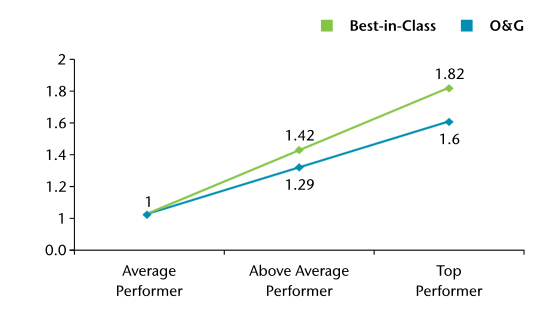Oil & Gas Industry: The Talent Conundrum
Greater focus on employee performance and productivity, especially post 2008 has led to the bell curve getting sharper each year.
All the O&G organizations clearly differentiate their superior performers. The primary objective of this differentiation is to ensure
external market competitiveness, ring fence critical talent and recognize talent for superior contributions made to the business.
Figure 2: Performance Differentiation in Organizations

Oil & gas industry closely mirrors some of the best-in-class organizations with moderate differentiation in terms of variable payouts
between top and average performer. It is important to ensure that the upside in the variable pay plan has a strong link with the level
of stretch built within the targets. Pay increases are also aligned to performance and market dynamics
Figure 3: Pay Increase Approach Adopted by Oil & Gas Organizations

Figure 3: Pay Increase Approach Adopted by Oil & Gas
Organizations Fixed increase approach refers to providing a fixed percentage increase for a particular rating/performance level;
whereas market linked approach refers to determining pay increases basis the differential to the market benchmarks and performance. Oil
& gas organizations typically have a fixed increment approach across a particular rating. However, the more evolved organizations in
O&G industry link it with market and individual performance. Most of the organizations maintain a relentless focus on performance while
deciding pay increments. Top performers are pegged between P75 and P90 of the market with average performers at P50 of the market.
And finally, the rewards practices are getting completely aligned to market
Whether it’s the average salary increases for promotion, average number of promotions or the prevalence of retention plans;
trends in the oil & gas sector are mirroring those of some of the best-in-class organizations; and in some cases, are even better
placed than the latter. The average salary increases for promotion cases stands at 13% for the O&G organizations vis-a-vis 10% for some
of the best-in-class organizations. Promotional increases are provided in a way that most organizations adopt an approach of placing
all incumbents getting promoted to the lower quartile of the next grade/level. Others ensure incumbents move to the minimum salary of
the next grade/level, provide a fixed percentage increase or move them to a target compa ratio. Retention plan payouts are determined
basis identification of key talent. Quantum of such payouts is typically in the range of 10-25% of either the total cost to company or
the total fixed pay. The lock-in period for such plans could vary from 1 to 4 years, and most organizations pay out this amount in a
phase-wise manner.
|